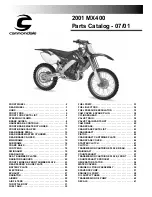
5. Undercharging or loose alternator belt
6. Excessive vibration (due to loose clamp or hold down on battery)
7. Corrosion
8. Freezing (A fully-charged vehicle battery will not freeze until the temperature is -75° F. Frozen batteries are
not warrantable.)
9. Failure to charge a battery during a period of six months or more (Inactivity can be extremely harmful to all lead
acid batteries.)
Battery Safety Guidelines
Prior to handling or working with a lead-acid battery, consult your battery owners' manual for instructions and
safety precautions.
Lead-acid batteries contain hydrogen-oxygen gases that may be explosive and sulfuric acid that may cause severe
burns.
To avoid injury, observe these precautions when handling or working with a lead-acid battery:
• Wear ANSI (American National Standards Institute) approved safety glasses or goggles, as well as a face
shield.
• Wear proper clothing to protect your face, hands, and body.
• Work in a well-ventilated area.
• Never lean over a battery while boosting, testing, or charging.
• Keep all ignition sources away from the battery. Cigarettes, flames, or sparks could cause a battery to explode.
• Always shield eyes and face from the battery.
• Do not charge or use booster cables or adjust post connections without proper instructions and training.
• Keep vent caps tight and level.
• In the event of an accident, flush eyes or skin with water, and call a physician immediately.
• Keep out of reach of children.
Cleaning the Battery
1. The battery should be cleaned using a baking soda and water solution. This should be a mixture of a couple of
tablespoons of baking soda per pint of water.
2. Both house and chassis battery cable connections need to be cleaned and tightened, as battery problems are
often caused by dirty and loose connections.
Checking the Fluid Level
1. A serviceable battery needs to have the fluid level checked.
If the battery
has removable vent caps, they can
be twisted or pried off with a flat-head screwdriver. Once removed, the individual vent wells can be seen.
2. Look down into each individual cell to make sure that the water is covering the lead plates and is at the
proper
level.
3. Add water to any cells that are low on water.
Ideally, the water level should be 1/8" below
the bottom of the tubes
(there are six
tubes in a 12 Volt battery) that go down into the battery.
To avoid damage to the battery, make sure
the fluid level never drops below the tops of the lead plates in each of the cells.
Always use
distilled water
to fill
the
battery to prevent battery contamination.
4. Do not
overfill battery cells.
Adding too much water
may result in acid overflow and damage around the battery.
In addition, warmer weather may cause natural fluid expansion, forcing excess electrolytes from the battery.
© 2016 Copyright Newmar Corporation. All rights reserved. For the most up-to-date version of this content, and for more product-specific information, please refer to Newgle.
3. Replacement using an undersized battery not meeting Newmar's OEM specifications
4. Loss of electrolyte
due to overheating or
overcharging
.
















































